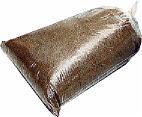Jarmila Jackson, Features Writer

One of hundreds of bats living in the ceiling of East's house.
When bulging sections of his ceiling began to break, Brian East realised there was something brewing.
Curiosity, coupled with the desire to repair the damage, led him to cut open a spot that would allow him entry. There, a mass of bat waste awaited him.
"I had on a long-sleeve shirt, put on a thing over my head, and a dust mask. I got about 200lb from this area here," he says, pointing to the ceiling above the bedroom. "We were very much uncomfortable with them. In the nights, you can hear that squeaky sound, hundreds of them live up there."
Living on a Gold mine
But what may have been a nasty nuisance, turned out to be a gold mine.
"My mom told me to get rid of them, but I heard somebody say one time that it is good manure, so I went on the computer and looked it up, and I asked some farmers about it. What I understand is that it's a very scarce commodity, but at the same time, very good. So, I decided to start selling it to try and make money to replace the salitex."
Although Brian and his mother have lived in their house in Salisbury Plain, west rural St Andrew, for 12 years, it is only in the last year that they've come to realise what value lies within the 36 inches between the ceiling and the roof.
To his mother's distress, the bats have always been there.
At 6:40 p.m., like clockwork, the bats begin to emerge from beneath the zinc roof of the two-storey house on hillside.
One by one, and then in swarms, they circle in the air for about three minutes before heading off into the night. They return just before dawn to their haven.
The idea of turning the nocturnal creatures' waste into money might seem weird - 'batty', even.
But now, 'Rat Bat Manure for Sale' can be seen on signs scrawled in red paint on pieces of board and placed all over Kingston.
jarmila.jackson@gleanerjm.com

A bag of guano, which is stored in East's chicken coop. - Photos by Andrew Smith/Photography Editor
BAT GUANO
It is a completely organic fertiliser, and can be applied in all kinds of cultivation.
The high concentration of organic matter and nutrients means that it can be used in lower doses than other organic fertilisers, which can save money.
It has a high phosphate content to promote larger blooms, rather than just overall growth.
It destroys the primary stage of nematodes, thus eliminating them. Eliminating nematodes protects the plant's radicular system, which improves nutrition and production.
It is a fungicide and also competes with disease-causing microbes.
In 17th-century Peru, the Incas valued guano so highly that the punishment for harming the animals that produced it was death.

A package of guano, ready for sale.

